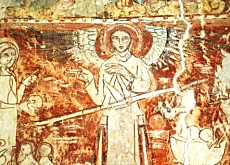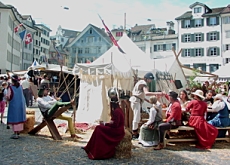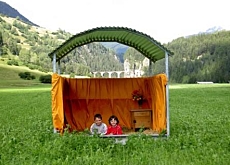Ascending Switzerland’s medieval stairways

What to do when your vacation is coming to an end and you as a time traveller only have a day to experience Switzerland as it was in the Middle Ages?
The answer: reserve your train ticket and car hire online and you have already taken the first step up the “Stairways to Heaven” – a journey of medieval discovery.
The new route links more than two dozen heritage sites – medieval castles, Romanesque churches and cultural landscapes – across canton Graubünden and the neighbouring mountain valleys of Italy.
A colourful map available in English includes pictures and brief descriptions of each site, which means visitors only have to sort out their own transport.
That is how I stumbled upon an offer by the Swiss Federal Railways called “Click & Drive”, allowing holidaymakers to do a one-day tour from Zurich of several of the locations and be back at their city hotel again for dinner.
What promised to be the ultimate do-it-yourself cultural experience for travellers with an allergy to guided tours began with a one-hour train journey to Chur – Graubünden’s neat and tidy capital.
After a few minutes at the station’s ticket counter, I was handed over my “Mobility” card, the key to the vehicle I had reserved for the day, parked nearby. But I started the journey with a brisk walk through the cobbled lanes of Chur, which claims to be Switzerland’s oldest settlement, dating back 5,000 years.
At the top of the town is the Bishop’s Court and Romanesque cathedral. This is where I met Mark Nay, one of the driving forces behind Stairways to Heaven.
Accessible Middle Ages
“The goal is to make the Middle Ages accessible for tourists interested in art history,” Nay told me.
“As populations grew over the centuries, many medieval structures in Europe were torn down to make way for larger buildings and wider roads, but because Graubünden is located on the periphery, its population has remained relatively stable and so a lot from the Middle Ages has been preserved.”
According to Nay, each step of the tour must be accessible to the public, with the local population acting as guides or putting together cultural programmes. The entire route must also highlight the diversity of the period: churches and chapels with wall paintings, well-preserved fortifications and castle ruins as well as terraced slopes.
Not wanting to waste much time, I threw a quick but admiring glance at the cathedral’s richly ornamented late Gothic altar, and the apostle columns guarding the bishop’s tomb before driving off to see the treasures spread around the countryside.
Next stop was the parish church in the hamlet of Brienz – about 40km away – where I searched for patron saint Acalixtus among the figures on the carved altar.
“His facial features with their lively, individual expression,” the brochure said, “already anticipate the Renaissance approaching from the south.” I was equally impressed by the mountain vistas from outside the church.
Further down the road, I used the small car park above the Viamala gorge to peer down the steep walls of what was once an important north-south trading route, opened by the Romans.
Sistine chapel
It was the “Sistine Chapel of the Alps” that lured me to Zillis at the Viamala’s southern approach. Mirrors are available inside so you don’t have to strain your neck to take in the painted, panelled ceiling.
The woman at the church’s ticket booth was equally entertaining, pointing proudly to the restored castle across the valley, which she said was not too long ago “just a pile of stones”.
But the ruins of the Hohen Rätien castle perched high above the town of Thusis was the tour’s piece de resistance. “It was already in my family before America was discovered,” laughs the owner and castle restorer, Ruedi Jecklin.
Jecklin inherited his old pile in the 1970s and has reassembled the keep, tower and houses. He shows me the excavations of a complex of religious buildings dating back to the fifth century, possibly a place of worship for followers of Mithraism, a mysterious Hellenistic religion.
The current king of the castle tells me the challenge now is to preserve what has been dug up. His stated goal rings true for all of the supporters of the Stairways to Heaven tour.
“We want to find a way to present it to visitors so they can get a better understanding of the history of the place, so they are not just looking at stones.”
swissinfo, Dale Bechtel in Graubünden
The Stairways to Heaven route includes 15 sites in canton Graubünden and 12 in Italy’s South Tyrol and Trentino regions.
The best known in Switzerland is the Convent of St John in Müstair, which is a Unesco World Heritage Site.
Some of the sites are open year round, but many only open their doors, or have staff on hand to answer questions, between April and October or in the summer.
In most cases, entrance is free of charge.
The guide to the sites is also complimentary and is best picked up at the tourist office in Chur. The website also provides a description of all of the listed buildings.

In compliance with the JTI standards
More: SWI swissinfo.ch certified by the Journalism Trust Initiative




You can find an overview of ongoing debates with our journalists here. Please join us!
If you want to start a conversation about a topic raised in this article or want to report factual errors, email us at english@swissinfo.ch.